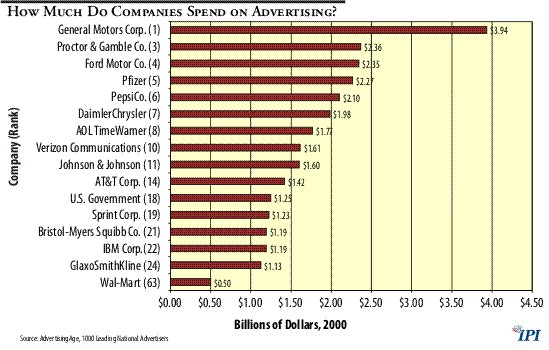General Motors does it. Wal-Mart does it. In fact, thousands of companies and industries do it. So why don’t they want prescription drug manufacturers to do it? Advertise, that is.
Drug companies have been advertising heavily for years, only no one cared because almost all of those ad dollars were directed at physicians and other health care providers.
All of that changed in 1997 when the U.S. Food and Drug Administration (FDA) relaxed some of its restrictions on the ability of drug companies to advertise direct-to-consumer (DTC). Since 1997, DTC prescription drug advertising has risen from $859 million to $2.49 billion, according to CMR, a data research company.
Now we have the irony of mega-advertisers such as GM and Wal-Mart, both part of a coalition that calls itself Business for Affordable Medicine, trying to limit drug company ads.
Why Are Drug Companies Advertising More? The U.S. health care system is transitioning from a physician-directed system to a patient-directed one. Increasingly, patients are entering the health care system armed with information—and sometimes misinformation. They may not know how to practice medicine, but many know something about their medical condition and the options available to them. It’s the demand for information that is driving the transition.
DTC advertising is simply a way for drug manufacturers to meet the growing consumer demand for information about their products and the medical conditions they treat.
Does Advertising Drive Up Costs? There is a common, but erroneous, assumption that advertising costs are added to the cost of producing a product, thereby making the product more expensive–and in the case of prescription drugs, unaffordable. But consider the market for over-the-counter drugs, such as Aleve and Advil. Those manufacturers advertise their products extensively and yet the products are relatively inexpensive.
The fact is that advertising in a competitive market lowers costs.
According to Advertising Age, in 2000 General Motors Corp. spent more on advertising in the U.S. than any other company—$3.935 billion—half again as much as Ford and twice what DaimlerChrysler spent. [See the figure.] Would GM maintain its products are competitively priced? Of course, and GM knows that if it tried to recover those advertising costs by increasing its prices, the company would lose customers to other auto manufacturers.

Wal-Mart spent half a billion dollars advertising its products in 2000 and still claims that it provides consumers with the lowest price—always.
If advertising spending really made products more expensive, why don’t GM, Wal-Mart and a host of other companies simply stop advertising and pass the savings along to consumers? Because without advertising, consumers wouldn’ t know who has the highest quality or the lowest prices.
Does Advertising Increase Spending on Prescription Drugs? Critics of DTC advertising also claim that advertising increases drug utilization and therefore spending. Of course, the purpose behind GM advertising its own products is to increase its market share—and profits.
Although GM would not consider it bad if a family, impressed by a GM ad, bought a second GM car, it deplores the possibility that people with medical conditions might respond similarly to prescription drug ads.
However, increased health care spending is only bad when it is wasteful and inefficient. For example, if doctors were to prescribe medicines for patients who had no medical need, that would be wasteful—and unethical. But very few doctors would prescribe medicines their patients do not need. In fact, a recent Prevention magazine survey found that about half of those who talked to a doctor as a result of a DTC ad received no drug therapy.
Another concern is that patients, having seen an expensive brand-name drug advertised, will want it rather than a generic equivalent. When patients or their doctors choose brand names over generics, their choices may increase total health care spending. But, again, that may not be bad. The brand name may be higher in quality or slightly different in composition. And it may have fewer side effects. Thus it may offer additional benefits, in which case the additional cost may be justified.
The goal in health care should be to ensure that people get the appropriate amount of care. If an expansion of DTC advertising means that we are treating more people who otherwise might have suffered in pain or endured a debilitating condition, then increased medical spending is positive.
Why the Opposition to Drug Companies Advertising? The primary reason is that the health care market does not work like other markets. Almost 90 percent of those under age 65 with private health coverage get it through their employers. Consumers may be using the products, but it’s the employers—such as GM and Wal-Mart—who are paying the bills. As a result, these companies are trying to limit another industry’s right to inform consumers—an action GM and Wal-Mart would never tolerate were their own advertising being challenged.
The solution to this problem isn’t to restrict patients’ access to information. It’s to return more control of health care dollars to consumers—such as switching to less-expensive high-deductible policies and Medical Savings Accounts—so that they will have an incentive to be prudent health care shoppers.
What’s the Key to Lower Drug Prices? Consider the wireless communications industry. In 2000, AT&T spent $1.4 billion on advertising, Verizon spent $1.6 billion and Sprint $1.2 billion. Even though these companies use cutting edge technology—like the field of medicine—competition forces them to keep their prices low. Competitive pressure can happen in the pharmaceutical industry as well—indeed, it already is happening.
Conclusion. It is ironic that companies that spend billions of dollars advertising their own products to consumers would try so hard to deny other companies that First Amendment right.
The key to lower drug costs is not restricting advertising, it is patient control. If employers are tired of paying the price for prescription drugs, then return control to patients and let the competition begin.
Dr. Merrill Matthews Jr. is a visiting scholar with the Institute for Policy Innovation.
